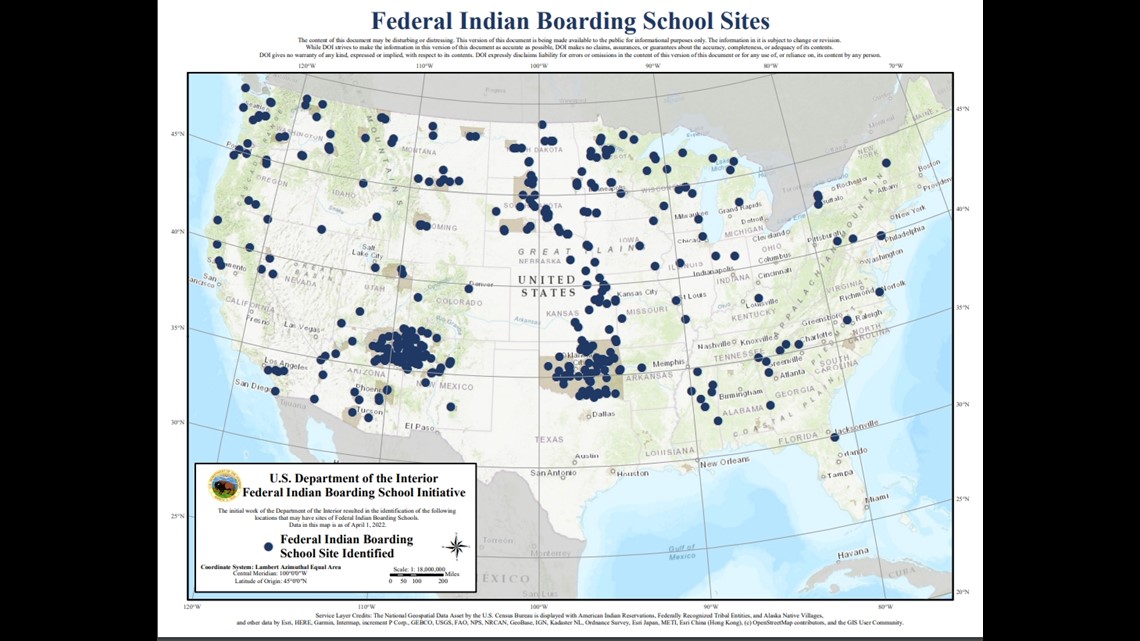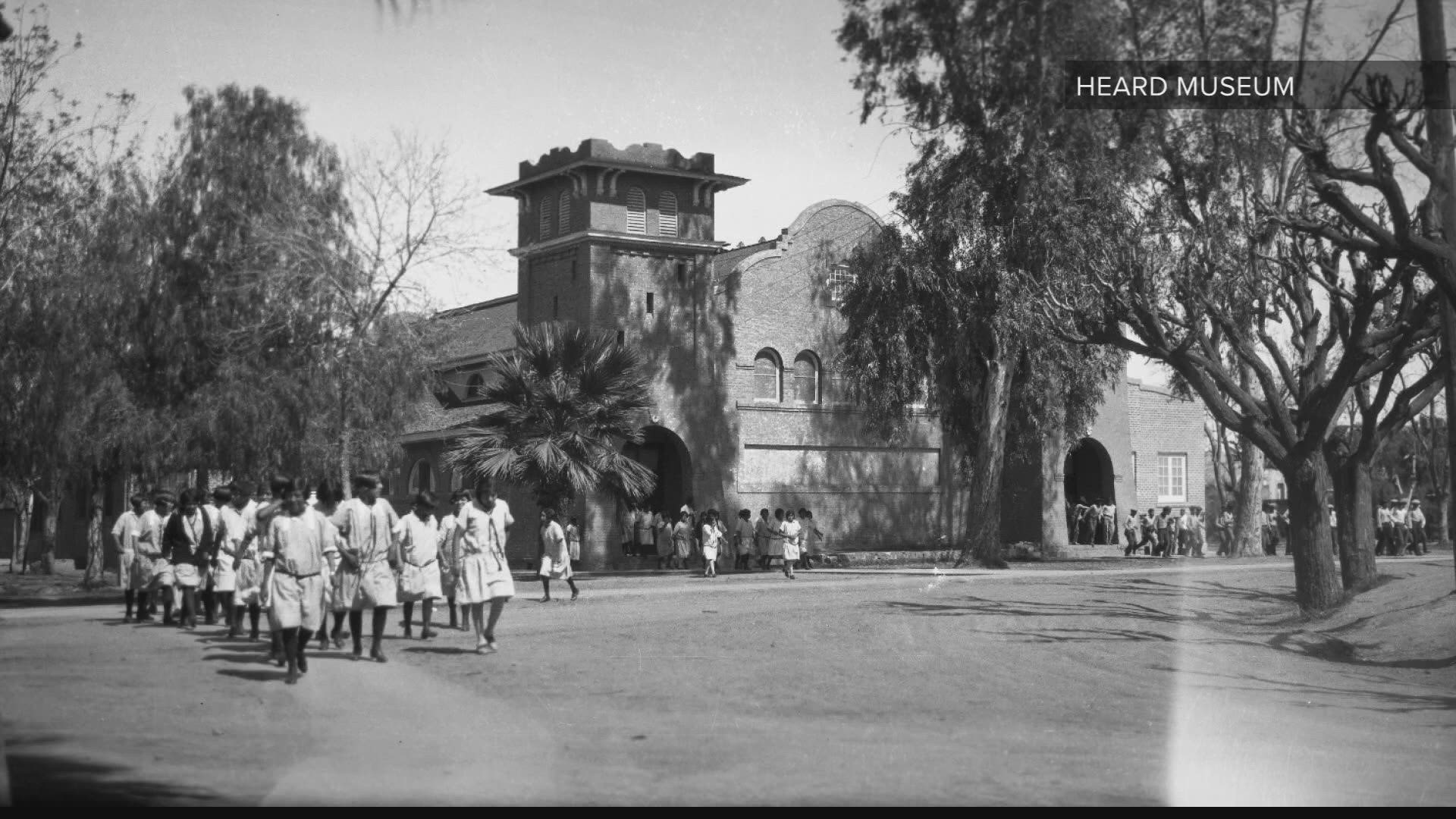WASHINGTON, D.C., USA — The Federal Government on Wednesday acknowledged for the first time the "heartbreaking and undeniable" history of Indian boarding schools across the U.S. that forced assimilation on Indigenous people.
Deb Haaland, Secretary of Interior and the first Native person in the position, said with a shaking voice at a news conference Wednesday the 408 institutions identified by her team were used to "exterminate and eradicate" Native people.
"My grandparents at 8 years old were taken away from their homes," Haaland said about her own experience with Indian boarding schools. "Each of those children is a missing family member."
Haaland spearheaded the government's first investigation into the history of these schools. Part one of the report was released Wednesday and identifies not only the schools, but also that 53 marked or unmarked burial sites have been identified at these schools.
Haaland said the department expects the number of burial sites to increase.
Resources:
The year-long investigation comes after hundreds of bodies of indigenous children, some as young as 3, were found at similar schools in Canada.
ORIGINAL STORY: Report: over 600 bodies found at Indigenous school in Canada
Arizona was home to 47 of these schools, the second most of any state in the U.S. Most were in the northern part of the state, but one of the longest-running schools was in Phoenix.
The Phoenix Indian School sat on the property now known as Steele Indian School Park on Central Avenue and Indian School Road in central Phoenix.
Locations of the burial sites will not be made public, the federal report says, "in order to protect against well-documented grave-robbing, vandalism, and other disturbances to Indian burial sites."
Inconsistent federal reporting of child deaths at boarding schools, including the number and cause or circumstances of death, and burial sites has made the investigation difficult, the report says.


With support from the Biden administration, Haaland said she will tour the former school locations to promote spiritual and emotional healing and allow Natives to come forward and share their stories.
"This is not new to many of us Indigenous people," Haaland said about the generational trauma seen in Native families to this day. "[We're] shining a bright and undeniable spotlight ... this is a significant step to address facts and consequences of these schools."
Haaland added during Wednesday's emotional news conference that the report was done by Indigenous staff in the department, many of who had to work through their own trauma related to the institutions.
The report
The 100-page report lacks specific details about schools but gives an overall look at the boarding school system and what life was like for so many Native children, where funding came from and how these schools were used for the feds to acquire land.
- From 1819 to 1969, the federal Indian boarding school system consisted of 408 federal schools across 37 states or then territories, including 21 schools in Alaska and 7 schools in Hawaii.
- Beginning with President George Washington, the stated policy of the Federal Government was to replace the Indian culture. It was considered “advisable” as the cheapest and safest way of subduing Natives, of providing a safe habitat for the country’s white inhabitants, of helping whites acquire desirable land, and of changing the Indian’s economy so that they would be content with less land.
- About 50% of federal Indian boarding schools received support or involvement from a religious institution or organization.
- The feds at times paid religious institutions and organizations on a per capita basis for Indian children to enter the federal Indian boarding schools that these institutions and organizations groups operated.
- The schools deployed systematic militarized and identity-alteration methodologies to attempt to assimilate American Indian, Alaska Native, and Native Hawaiian children through education, including renaming Indian children from Indian to English names, cutting their hair, banning the use of Native languages, religions, and cultural practices; and organizing children into units to perform military drills.
- Punishment included solitary confinement; flogging; withholding food; whipping; slapping; and cuffing.
- The Federal Government has not provided a forum or opportunity for survivors or descendants of survivors of federal Indian boarding schools, or their families, to voluntarily detail their experiences in the federal Indian boarding school system.
“This report presents the opportunity for us to reorient federal policies to support the revitalization of Tribal languages and cultural practices to counteract nearly two centuries of federal policies aimed at their destruction,” said the Interior Department's Assistant Secretary for Indian Affairs Bryan Newland.
“Together, we can help begin a healing process for Indian Country, the Native Hawaiian Community and across the United States, from the Alaskan tundra to the Florida everglades, and everywhere in between.”
Next steps
Newland, who penned the report, laid out eight steps in moving forward with the initiative:
1. Continue full investigation, including locating marked and unmarked burial sites associated with a particular Indian boarding school facility or site, which may later be used to assist in locating unidentified remains of Indian children, Indian Prisoners of War, and Freedmen from the Five Civilized Tribes.
2. Identity surviving Federal Indian boarding school attendees. Develop a system for voluntary identification of surviving now-adult attendees, including communication methodologies.
3. Document Federal Indian boarding school attendee experiences. Develop a platform for now-adult Federal Indian boarding school attendees and their descendants to formally document their historical accounts and experiences, and understand current impacts such as health status, including substance abuse and violence.
4. Support protection, preservation, reclamation, and co-management of sites across the Federal Indian boarding school system where the Federal Government has jurisdiction over a location.
5. Develop a specific repository of Federal records involving the Federal Indian boarding school system at the Department of the Interior Library to preserve centralized Federal expertise on the Federal Indian boarding school system.
6. Identify and engage other Federal agencies to support the Federal Indian Boarding School Initiative, including those with control of any records involving the Federal Indian boarding school system or that provide health care to American Indians, Alaska Natives, and Native Hawaiians, including for the provision of mental health services to students attending Bureau of Indian Education (BIE) operated and funded schools.
7. Support non-Federal entities that may independently release records under their control. To make the Federal investigation more thorough and accurate, support non-Federal entities, such as States and religious institutions and organizations, including those that have received Federal funding to operate Federal Indian boarding schools, that may independently release records relating to the Federal Indian boarding school system such as those that cover Indian child removal and provision of health care services to Indians, including at military installations.
8. Support Congressional action involving the following policies: • NAGPRA.


Up to Speed
Catch up on the latest news and stories on the 12 News YouTube channel. Subscribe today.

